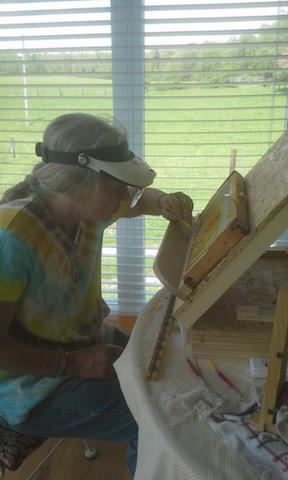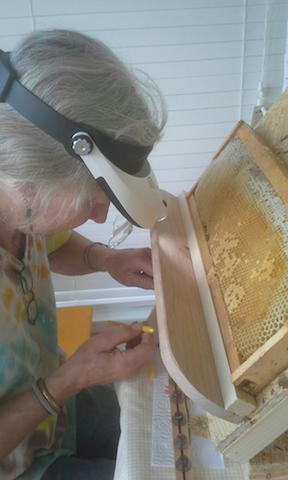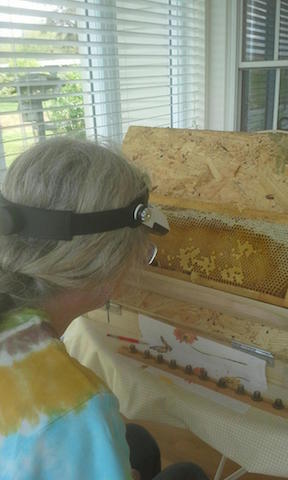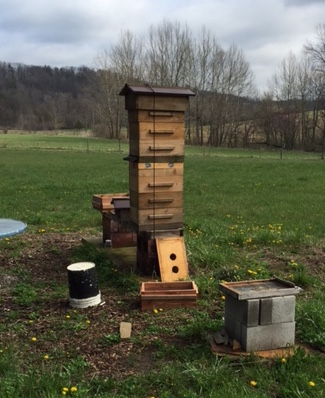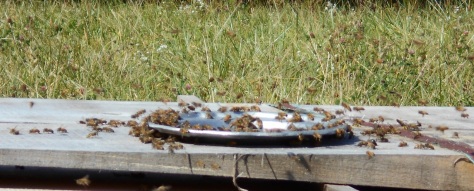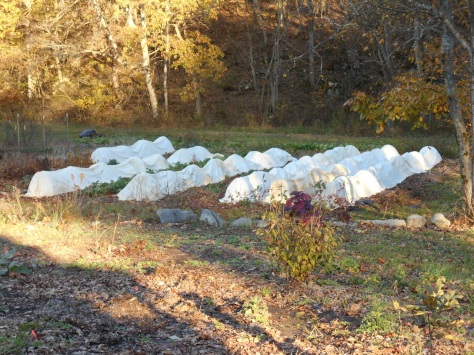As a newbee member of the Cumberland County Beekeepers Association, I’ve been assigned a mentor. I’ve read about 3 books, countless older copies of The American Bee Journal and Bee Culture, looked through every beekeeping catalog made, been to a conference, built hives, got all the equipment needed, but today I got to actually go into beehives for real! I was humming that song “I’m so excited, and I just can’t hide it, I know, I know….” anyway, the day was beautiful and warm for this time of year. My mentor has hives off the mountain (the Cumberland Plateau) so she thought it would be warmer to work those hives today.
I gathered up all my brand new bee stuff, most of it still in the plastic packages, loaded them in my Subaru Veggie-soon-to-become a Veggie/Bee Wagon, and headed to her house. She has a Subaru beewagon with a bee-trailer behind it and it was loaded with supers, frames, sugar syrup, bottom boards–more beekeeping equipment than I’d ever seen! She made sure I had everything I needed and all I have is a jacket so she was going to loan me a pair of white pants to slip on over my jeans. We went into the building where she keeps all her bee stuff and got distracted talking and left without getting the white pants—haha!
On the way to the bee yard we came upon a yard sale…….the bees can wait!
 We each got a few things and went on to the bee yard.
We each got a few things and went on to the bee yard.
The first thing we did once we got there was to light our smokers. I’ve never lit a smoker and I even commented to her that mine came with paper to light it the first time–it was the instructions on how to light it! I stuffed paper egg carton in my shiny new smoker and lit it. After stuffing a few pine needles and cones in it I had a pretty good fire going. I’m used to building a fire in a wood stove, not a coffee can. Although I got a fire going pretty quick and it was doing really well, in the end hers kept smoking the entire time, about 2 hours, and mine went out. I need practice.

She has nine hives at this farm and was doing the first actual hands on visit for the season. We could see from a distance that 2 of the hives weren’t as busy as the others and she said she knew that one of them hadn’t survived the winter. We started opening hives, checking for brood, and changing out the bottom boards for ones that she had cleaned up and painted. I got to see lots of things I’ve never seen before….
 I’ve seen pictures of the “baggy” feeders, but have never seen them in person. A great, inexpensive way to feed bees sugar syrup without drowning them.
I’ve seen pictures of the “baggy” feeders, but have never seen them in person. A great, inexpensive way to feed bees sugar syrup without drowning them.
I believe this was one of the hives that had died, and there were just robber bees in there getting honey.
 This was a frame that had honey on it. When she pulled out a frame and asked me if I could see the eggs and larvae, I squinted and looked and tilted the frame every which way and couldn’t see anything. Then I handed it back to her and said “I guess I need to go get my glasses”. She cracked up. After I got my glasses on I could see the larvae and the eggs. It’s much easier to see them after you know what they look like–teeny tiny little itty bitty things…….
This was a frame that had honey on it. When she pulled out a frame and asked me if I could see the eggs and larvae, I squinted and looked and tilted the frame every which way and couldn’t see anything. Then I handed it back to her and said “I guess I need to go get my glasses”. She cracked up. After I got my glasses on I could see the larvae and the eggs. It’s much easier to see them after you know what they look like–teeny tiny little itty bitty things…….
 This frame had queen cups on it. When they are on the bottom of the frame like this I believe they are called swarm cells and that’s when the bees build queen cells, the queen lays eggs in there and then she takes half the bees in the hive with her and they leave…..something beekeepers try to avoid.
This frame had queen cups on it. When they are on the bottom of the frame like this I believe they are called swarm cells and that’s when the bees build queen cells, the queen lays eggs in there and then she takes half the bees in the hive with her and they leave…..something beekeepers try to avoid.
I saw a few hive beetles but those pictures were blurry–little small black round bugs that move around the hive–very destructive little bugs, I might add. They can kill a hive if not kept in check, but I only saw 3 in all the hives today. She also showed me some drones–they are bigger than the worker bees, and I saw two queens. One of them had a big white mark on her head–she was easy to spot! The other one took a little time and she kept going into hidey-holes so we couldn’t see her. I did not get a picture of a mouse nest either. It had actually built a nest in one of the frames and had eaten holes in several other frames, but we didn’t see the mouse. The bees will repair the holes in the foundation so she just put them back into the hive.
Another very exciting thing I saw was a bee actually coming out of its cell–being born, if you will! I was so excited. That was way cool! The bee crawled out of her cell then turned right around and cleaned it out–AWESOME! Bees are so interesting!
That’s about it for the first day of beekeeping–well, keeping someone else’s bees. Mine are supposed to arrive in mid-late April and I can hardly wait. The apiary is almost complete and ready for bees…….and no stings today!

